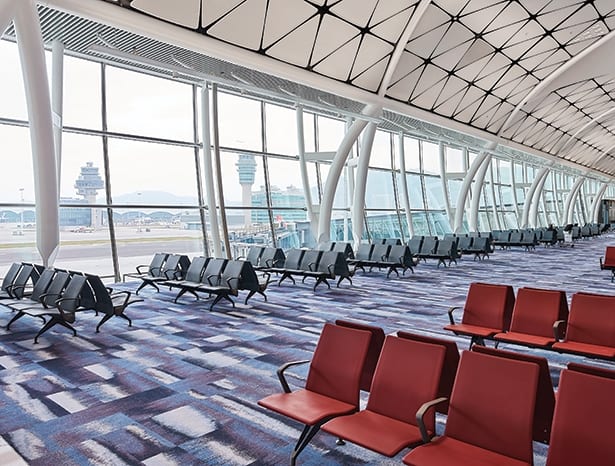 Zoeftig Infinite seats at Hong Kong International Airport|||
Zoeftig Infinite seats at Hong Kong International Airport|||
Charles and Ray Eames’ Tandem Sling is an iconic design, one of the first to address the need for comfortable, resilient and attractive public seating. Designed in 1962 for Chicago’s O’Hare International Airport, the seat is still manufactured today by Herman Miller and Vitra.
The enduring appeal of the Eameses’ work shows that for airport seating, comfort and elegance make for a continuously relevant design. That said, the industry has evolved alongside international travel, with the emergence of several new trends: non-linear design, more colourful and playful designs, incorporation of technology and accessories, and a greater focus on user wellbeing.
Studioilse has worked closely with Cathay Pacific Airways in recent years to provide a range of airport lounges that team understated luxury with comfort – design that feels more like that of a living environment. At the end of last year the London-based studio designed a new lounge for Taiwan’s Taoyuan International Airport, offering a relaxing environment where First and Business Class passengers can unwind before flights.
Wellbeing is at the heart of the design, thanks to the warm, natural materials and Studioilse’s innovative approach to seating. The Taipei lounge was the first to feature the Solo chair, a spacious seat designed with high partitions for greater privacy. A sense of home comfort is key and each chair features a side table, reading lamp, coat hook and power sockets. Users benefit from flexibility and a personalised experience: curling up, sitting and relaxing or catching up on admin.
 Studioilse’s Business Class at Hong Kong with timber screens
Studioilse’s Business Class at Hong Kong with timber screens
In 2016, Studioilse created a Business Class lounge at Hong Kong International Airport with seating for 550 people. It once again used the Solo chair, this time with the additional appeal of views through large glass windows and glazed timber screens.
Zoeftig is a leading manufacturer of seating for passenger terminals and waiting areas, catering new designs to the changing industry. “The design and layout of airport terminals have evolved significantly in the past 10-20 years,” says Ian Coates, its design engineering and quality director. “The growth of new airports in developing nations and new territories has been significant, and has brought to the fore the demand for a range of seating solutions, to fit the varying needs of individual customers. Some passengers demand areas for comfort and relaxation, while for others, where dwell time is much shorter, different finishes and comfort levels are needed – it’s the job of the supplier, alongside the architects and designers, to select the right mix to meet demand.”
Coates identifies five leading airport seating trends at present: “wider configurations beyond the linear form”, “recognition, by all partners in the design process, that there isn’t just one type of customer, so shouldn’t be one type of seating solution”, “seating [that] is increasingly treated as an integral part of the fabric of the airport”, “passenger demand for 24/7 connectivity” and “the need to future-proof seating”.
Connection was at the core of the Hong Kong airport fit-out earlier this year, where more than 5,500 of Zoeftig’s Infinite seats and 1,600 of its power positions were installed. The bespoke designs, installed in red and grey, feature individual USB charging modules, allowing passengers to recharge their devices. Twin sockets provide 2.4 amps of power simultaneously, whereas traditional socket USB charging points supply a max of 1.2 amps when both sockets are in use.
 Charles & Ray Eames’ 1962 Tandem Sling is still in use
Charles & Ray Eames’ 1962 Tandem Sling is still in use
Tech integration and non-linear trends were also explored in Zoeftig’s fit-out for San Diego International – the seating arrangements providing a private area with table and built-in power outlet, Zoeftig’s PowerArm.
As part of the airport’s ongoing Green Build programme, almost every component used in the seats is 100% recyclable, and the modular units can be easily reconfigured if airport requirements change, which addresses the need for future-proofing.
Global textile manufacturer Camira Fabrics offered some of the quirkiest examples of airport seating that I found, in a project for London Gatwick. Passenger seating specialist Race Furniture selected a custom-made Gatwick Cityscape fabric, the design for which was supplied to Camira’s product designers, who translated it on to a wool/nylon fabric. The fabric, showing various well-known London landmarks, was used in the north and south terminals and creates a fun, visual alternative to the traditional block colour of airport seating.
“In general, clients are becoming more adventurous with colour and design,” says Catherine Counsell, Camira Fabrics’ design and development manager.
“As the gap between trends in fashion and interior design becomes ever smaller, people are becoming more comfortable with contemporary design and braver colour schemes as they are seeing it all around them every day.”
 Camira Fabrics’ seating in Manchester Airport’s Escape Lounge
Camira Fabrics’ seating in Manchester Airport’s Escape Lounge
Manchester Airport’s Terminal 3 Escape Lounge used another bright seating solution, where the Camira fabric and furniture choices created “zones” to cater for differing moods and passenger needs.
Colour and aesthetic are crucial to public seating design “both in terms of defining areas within a scheme but also in terms of colour psychology – how different colours can influence elements such as mood, concentration or relaxation,” says Counsell.
As spaces where thousands of users ready themselves for travel every day, designers of airport seating zones have adopted many ways to enhance the customers’ experience of their surroundings.
From Charles and Ray Eames’ Tandem Sling to Studioilse’s Business Class lounge at Hong Kong International Airport



























